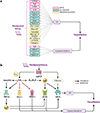Mechanosensing by Vascular Endothelium
- PMID: 37863105
- PMCID: PMC10922104
- DOI: 10.1146/annurev-physiol-042022-030946
Mechanosensing by Vascular Endothelium
Abstract
Mechanical forces influence different cell types in our bodies. Among the earliest forces experienced in mammals is blood movement in the vascular system. Blood flow starts at the embryonic stage and ceases when the heart stops. Blood flow exposes endothelial cells (ECs) that line all blood vessels to hemodynamic forces. ECs detect these mechanical forces (mechanosensing) through mechanosensors, thus triggering physiological responses such as changes in vascular diameter. In this review, we focus on endothelial mechanosensing and on how different ion channels, receptors, and membrane structures detect forces and mediate intricate mechanotransduction responses. We further highlight that these responses often reflect collaborative efforts involving several mechanosensors and mechanotransducers. We close with a consideration of current knowledge regarding the dysregulation of endothelial mechanosensing during disease. Because hemodynamic disruptions are hallmarks of cardiovascular disease, studying endothelial mechanosensing holds great promise for advancing our understanding of vascular physiology and pathophysiology.
Keywords: G protein–coupled receptors; Piezo1; endothelial cells; ion channels; mechanosensing; mechanosensors; mechanotransduction; shear stress.
Figures




Similar articles
-
Integrating molecular and cellular components of endothelial shear stress mechanotransduction.Am J Physiol Heart Circ Physiol. 2024 Oct 1;327(4):H989-H1003. doi: 10.1152/ajpheart.00431.2024. Epub 2024 Aug 23. Am J Physiol Heart Circ Physiol. 2024. PMID: 39178024 Review.
-
Nuclear mechanosensing of the aortic endothelium in health and disease.Dis Model Mech. 2023 Oct 1;16(10):dmm050361. doi: 10.1242/dmm.050361. Epub 2023 Nov 1. Dis Model Mech. 2023. PMID: 37909406 Free PMC article. Review.
-
Endothelial Mechanosignaling: Does One Sensor Fit All?Antioxid Redox Signal. 2016 Sep 1;25(7):373-88. doi: 10.1089/ars.2015.6493. Epub 2016 Mar 30. Antioxid Redox Signal. 2016. PMID: 27027326 Free PMC article. Review.
-
Piezo1 channels are mechanosensors in human fetoplacental endothelial cells.Mol Hum Reprod. 2018 Oct 1;24(10):510-520. doi: 10.1093/molehr/gay033. Mol Hum Reprod. 2018. PMID: 30085186 Free PMC article.
-
Emerging Role of Plasma Membranes in Vascular Endothelial Mechanosensing.Circ J. 2018 Oct 25;82(11):2691-2698. doi: 10.1253/circj.CJ-18-0052. Epub 2018 Oct 4. Circ J. 2018. PMID: 30282847 Review.
Cited by
-
Piezo ion channels: long-sought-after mechanosensors mediating hypertension and hypertensive nephropathy.Hypertens Res. 2024 Oct;47(10):2786-2799. doi: 10.1038/s41440-024-01820-6. Epub 2024 Aug 5. Hypertens Res. 2024. PMID: 39103520 Review.
-
Venous thrombosis and obesity: from clinical needs to therapeutic challenges.Intern Emerg Med. 2025 Jan;20(1):47-64. doi: 10.1007/s11739-024-03765-7. Epub 2024 Sep 13. Intern Emerg Med. 2025. PMID: 39269539 Free PMC article. Review.
-
Endothelium Piezo1 deletion alleviates experimental varicose veins by attenuating perivenous inflammation.Mol Cell Biochem. 2025 Apr;480(4):2423-2435. doi: 10.1007/s11010-024-05115-9. Epub 2024 Sep 9. Mol Cell Biochem. 2025. PMID: 39249600
-
Thrombospondin-1 mitigates osteoarthritis progression by inhibiting mechanical stress-induced chondrocyte ferroptosis via the integrin/YAP pathway.Front Immunol. 2025 May 22;16:1577234. doi: 10.3389/fimmu.2025.1577234. eCollection 2025. Front Immunol. 2025. PMID: 40475787 Free PMC article.
-
Transmembrane Protein-184A Interacts with Syndecan-4 and Rab GTPases and Is Required to Maintain VE-Cadherin Levels.Cells. 2025 Jun 3;14(11):833. doi: 10.3390/cells14110833. Cells. 2025. PMID: 40498012 Free PMC article.
References
-
- Cecchi E, Giglioli C, Valente S, Lazzeri C, Gensini GF, et al. 2011. Role of hemodynamic shear stress in cardiovascular disease. Atherosclerosis 214(2):249–56 - PubMed
Publication types
MeSH terms
Substances
Grants and funding
LinkOut - more resources
Full Text Sources

